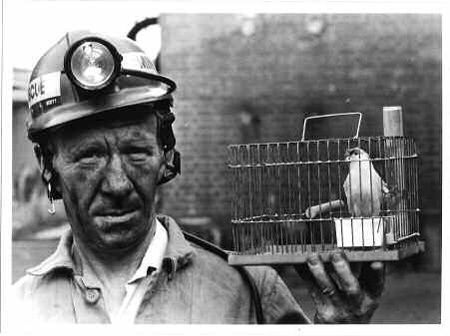
Today, a bird anatomy lesson.
You’ve probably heard the phrase “the canary in the coal mine” and know it refers to advanced warning of a danger. In the centuries before air quality instruments, miners carried canaries in cages into the mines to detect carbon monoxide and methane before they reached dangerous levels for humans.
Why did we use birds to detect bad air? Why not some other small animal?
Birds are uniquely equipped to detect (and succumb!) to bad air because their respiratory systems are so efficient. Here’s why.
Our lungs suck in air, exchange oxygen for carbon dioxide, and push it out. This is slightly inefficient because some air remains in our lungs after we exhale. If you’ve ever had “the wind knocked out of you” you know it feels awful to lose that residual air.
Birds’ lungs don’t expand and contract; they only perform the oxygen-CO2 exchange. Instead birds have 7 to 12 air sacs that act like bellows, moving air in and out of the lungs and the body. The air sacs (pink below) move air in only one direction through the lungs (dark blue below), pushing all of one breath out when the next one comes in. No residual air!

Because the air sacs perform different functions, each air molecule takes 4 steps to pass through the bird’s body –> two in/out breaths.
1st Breath, Air molecule enters the bird.
1. Inhalation: Molecule is sucked into the body by the posterior (back of the bird) air sacs
2. Exhalation: Posterior air sac pushes molecule into bird’s lungs
2nd Breath, Air molecule leaves the bird.
3. Inhalation: Molecule is pulled out of the bird’s lungs by the anterior (front) air sacs
4. Exhalation: Anterior air sac pushes molecule out of the bird!
In this way, birds have more time to absorb oxygen from each breath and their bodies notice airborne poisons sooner than mammals do.
To put it all together, here’s a four and a half minute video that shows how it works.
One more amazing feat: The thin walls of birds’ air sacs can extend into the hollow bones of their wings and legs. They have extra places to store air!
(photo credits: Click on the captions to see the originals in context.
*Station Officer John Scott with canary cage used in coal mines rescue training at Cannock Chase, UK. Image courtesy of the Museum of Cannock Chase. Copyright unknown.
*Bird respiratory system diagram from Wikimedia Commons.
*Video of bird respiration by Ammt Bio on YouTube)
Interesting. Thanks, Kate!
Kate thanks for pointing out that birds lungs are more efficient than human’s lungs! I think sometimes humans get caught in the trap of thinking we are the most advanced animals on the planet and it can be surprising to discover that is not true.
I think they mean advanced in the ability to think, reason, etc. etc.
A few years ago the old connection at the back of my gas stove came loose but I did not realize it until my canary, Joe Tinker, had convulsions and died. I then investigated and discovered the problem. I had two small rabbits at the time and took them to the vet, who said their liver enzymes were elevated indicating they probably had been poisoned as well, but being bigger and mammals they did not yet show any ill effects. She said MY liver enzymes were probably elevated too. So, if it weren’t for poor little Joe Tinker we all would have become ill or possibly had an explosion from the leaking gas.
I don’t get it
Lexi, Smithsonian Magazine has an article about this What Happened to the Canary in the Coal Mine? The Story of How the Real-Life Animal Helper Became Just a Metaphor